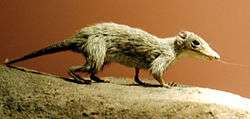Megazostrodon
| Megazostrodon Temporal range: Late Triassic–Early Jurassic | |
|---|---|
 | |
| Megazostrodon model, Natural History Museum, London | |
| Scientific classification | |
| Kingdom: | Animalia |
| Phylum: | Chordata |
| Subphylum: | Vertebrata |
| (unranked): | Amniota |
| Class: | Synapsida |
| (unranked): | Mammaliaformes |
| Order: | Morganucodonta |
| Family: | Megazostrodontidae Gow, 1986 |
| Genus: | Megazostrodon Crompton & Jenkins, 1968 |
Megazostrodon is an extinct Mammaliaform that is widely accepted as being one of the first mammals and which appeared in the fossil record approximately 200 million years ago.[1] It did have some non-mammalian characteristics[2] but they were sufficiently minor to warrant the analysis that this animal probably represents the final stage of the transition between cynodont, or "mammal-like" reptiles and true mammals.[3]
Characteristics
Megazostrodon was a small, furry,[4] shrew-like animal between 10 to 12 centimetres (3.9 to 4.7 in) long which probably ate insects and small lizards. It is thought that it was nocturnal as it had a much larger brain[1] than its cynodont relatives and the enlarged areas of its brain were found to be those that process sounds and smells. This was probably in order to avoid being in competition with the reptiles or becoming prey to the dinosaurs.[5]
Evolution
Megazostrodon is the only well-known genus of the family Megazostrodontidae. The other members of this family that are currently known to science are Indozostrodon, Dinnetherium, Wareolestes and Brachyzostrodon. The megazostrodontids used to be classified as members of a group of mammals called the Triconodonts, which are thought to have evolved from a specific group of reptiles (the cynodonts or 'mammal-like reptiles’)[6] during the late Triassic and early Jurassic periods. However, recent classifications consider the megazostrodontids to be mammaliaforms just outside the Mammalia proper, while the triconodonts remain in the (crowngroup) Mammalia. One must keep in mind that the distinction between true mammals and mammaliaformes is purely a cladistic and phylogenetic one: mammaliaforms are mammals in every other way.
These early mammals developed many traits which were to make them well-suited for a very active lifestyle. They developed four types of teeth[7] (as opposed to the uniform teeth of the reptiles), incisors, canines, premolars and molars, which enabled them to chew and therefore process their food more thoroughly than their reptilian cousins. There is evidence that the inward-closing movement of the mandible suggests a shearing action to chew food.[8] Their skeletons changed so that their limbs were more flexible (they became less laterally splayed,[9] allowing for faster forward motion) and they developed a shorter ribcage and larger lungs[7] to allow for faster respiration. The structure of their jaw bones changed, the lower jaw becoming a single bone — the dentary (as opposed to the seven different bones found in reptilian lower jaws). The other bones which once made up the jaw moved to the middle ear[1] to create a hearing system.
Probably the most important aspect of change in the evolution that led to these first mammals was that their direct ancestors (the cynodonts) had become warm-blooded. This meant that they relied on the food they ate to help sustain their body temperature rather than depending on their surrounding environment, which enabled them to maintain higher activity levels during the day than reptiles could (as reptiles frequently have to perform temperature regulation activities such as sun basking and seeking shade) and even to become nocturnal — a major advantage in a world where most predators were active during the day.
Reproduction
Despite all the mammalian traits that Megazostrodon acquired, it is thought that they still laid leathery eggs like their reptilian cousins, similar to the extant monotremes. Live birth and the placenta would be later evolutions for mammals.
Like placentals and possibly Erythrotherium, Megazostrodon is unique among mammaliformes in lacking epipubic bones, implying that it wasn't restricted to giving birth to undeveloped young. [10]
Discovery
Megazostrodon rudnerae was first discovered in Lesotho of southern Africa by Ione Rudner (whose surname was given to the animal’s specific name) in 1966.[11] It was, however, first described by A.W. Crompton and F.A. Jenkins Jr in 1968.[12]
Its name means, literally, ‘Rudner’s large girdle tooth’ (from the Greek mega-large, zostros-girdle and don-tooth — referring to the large external cingula, or ridges of the upper molars).
See also
Notes
- 1 2 3 Fur and Fangs: Mammal Origins. Palaeobiology and Biodiversity Research Group, University of Bristol.
- ↑ some should be mentioned.
- ↑ Historical Biology. 1992, vol. 6 p.186
- ↑ Its fuzziness is extrapolated from the fact that its skeletal morphology implies a warm-blooded animal with a high metabolism, and warm-blooded animals are covered with insulatiing features like feather, down, or hair in mammals.
- ↑ Smithsonian Science Abstract
- ↑ Mammology Sam Houston State University.
- 1 2 First Mammals Appear
- ↑ Savage, R.J.G., and Long, M.R. (1986). Mammal Evolution: an illustrated guide. Facts On File Inc. p. 41. ISBN 0-8160-1194-X.
- ↑ Mammalian Characteristics. Sam Houston State University.
- ↑ Jason A. Lillegraven, Zofia Kielan-Jaworowska, William A. Clemens, Mesozoic Mammals: The First Two-Thirds of Mammalian History, University of California Press, 17/12/1979 - 321
- ↑ Dinosaur Mailing List
- ↑ Crompton and Jenkins, "Molar occlusion in late Triassic mammals", Biological Review, 43 1968:427-458.
External links
- FUR AND FANGS-MAMMAL ORIGINS
- First mammals appear
- First Mammals and Plate Tectonics
- A brief history of mammalogy.
- Vertebrate paleontology-Michael J. Benton.